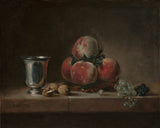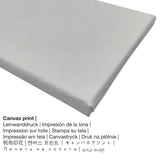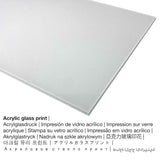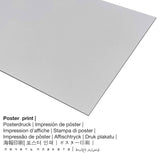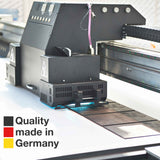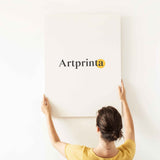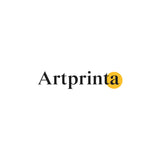Jean-Baptiste-Simeon Chardin, 1760 - Ndụ ka na peaches, ọla ọcha, mkpụrụ vaịn - mbipụta nka mara mma.
Ụtụ gụnyere. Mbupu gbakọrọ na ndenye ọpụpụ.
Onyinye ngwaahịa nka
Na 1760 na French artist Jean-Baptiste-Simeon Chardin agba nke 18th narị afọ artwork akpọ "Still Life with Peaches, a Silver Goblet, Grapes". Ihe gafere 260 afọ mbụ tụrụ nha: 38,1 x 46,7 cm na e mere ya na Usoro mmanụ na kwaaji. Moveover, the work of art is included in the digital art collection of Ụlọ ihe ngosi nka nke J. Paul Getty, which is part of the J. Paul Getty trust and is one of the world's largest arts organizations worldwide. It seeks to inspire curiosity about, and enjoyment and understanding of, the visual arts by collecting, conserving, exhibiting, and interpreting works of art of outstanding quality and historical importance.. The masterpiece, which belongs to the public domain is supplied with courtesy of Ụlọ ihe ngosi nka nke J. Paul Getty.Besides, the artpiece has the creditline: . Moreover, alignment is odida obodo with an image ratio of 1.2 : 1, which implies that the length is 20% longer than the width. The painter Jean-Baptiste-Siméon Chardin was an artist, whose style can be classified as Baroque. The French painter was born in 1699 na Paris ma nwụọ mgbe ọ dị afọ 80 na 1779.
Nkọwa ndị ọzọ sitere na J. Paul Getty Museum (© Nwebiisinka - Ụlọ ihe ngosi nka J. Paul Getty - Ụlọ ihe ngosi nka nke J. Paul Getty)
"It is the air and light you take with the tip of your brush and fix to your canvas...[your work] exists between nature and art," wrote Denis Diderot of Jean-Siméon Chardin in his Salon review of 1765. In still lifes, genre scenes, and the occasional portrait, Chardin's skill at rendering the visual and tactile qualities of simple objects won him the admiration of critics like Diderot.
In this small still life, Chardin portrayed a modest subject--three walnuts, four peaches, two bunches of grapes, and a pewter mug--but gave the objects monumentality by arranging them in pure geometric groupings and concentrating on their basic forms. He suggested the objects' various textures and substances through the play of light across surfaces and successive applications of paint. In this way, Chardin conveyed the fuzzy skin of the peaches, the hard, brittle shell of the walnuts, the translucence of the grapes, and the heavy, cold exterior of the pewter mug.
Data ndabere na mpempe nka izizi
| Aha nka: | "Still Life with Peaches, a Silver Goblet, Grapes" |
| Nhazi nka: | sere |
| Category: | nka ochie |
| oge: | 18th narị afọ |
| Afọ nka: | 1760 |
| Ogologo afọ nka nka: | karịa afọ 260 |
| Ọkara nke ihe osise izizi: | mmanụ na kwaaji |
| Ogo nke ọrụ nka izizi: | 38,1 x 46,7 cm |
| Ụlọ ihe ngosi nka / mkpokọta: | Ụlọ ihe ngosi nka nke J. Paul Getty |
| Ebe ebe ngosi nka: | Los Angeles, California, Njikota Obodo Amerika |
| Weebụsaịtị nke ihe ngosi nka: | www.getty.edu |
| Ikikere nke ihe osise: | ngalaba ọha |
| Site n'aka: | Ụlọ ihe ngosi nka nke J. Paul Getty |
Ozi omenka
| Ihe nkiri: | Jean-Baptiste-Simeon Chardin |
| okike nke onye nka: | nwoke |
| Obodo onye nka: | French |
| Ọrụ nke onye na-ese ihe: | onye na-ese ihe |
| Mba onye si: | France |
| Otu nka: | nna ukwu ochie |
| styles: | Baroque |
| Afọ ọnwụ: | 80 afọ |
| Amụrụ n'afọ: | 1699 |
| Obodo ọmụmụ: | Paris |
| Nwuru: | 1779 |
| Obodo ọnwụ: | Paris |
Ngwa ngwaahịa ị nwere ike ịhọrọ:
Anyị na-enye ihe dị iche iche dị iche iche na nha maka ngwaahịa ọ bụla. N'ihi ya, anyị na-enye gị ohere ịhọrọ n'ime nhọrọ ndị a:
- Mbipụta iko acrylic (nke nwere ezigbo mkpuchi iko): An acrylic glass print, which is often referred to as a plexiglass print, will turn your favorite original artwork into brilliant décor. Further, the acrylic print is a good alternative to canvas and aluminidum dibond prints. The artwork will be printed with state-of-the-art UV printing machines. With an acrylic glass fine art print contrasts as well as smaller image details become visible because of the delicate gradation in the print.
- Mbipụta nke aluminom: These are metal prints on aluminium dibond with an impressive effect of depth - for a modern look and a non-reflective surface. For our Direct Aluminium Dibond option, we print your chosen artwork onto the surface of the white-primed aluminum composite. The bright and white parts of the artpiece shimmer with a silk gloss, however without any glare.
- Mpempe akwụkwọ mmado ebipụtara na akwa akwa: The Artprinta poster print is a UV printed canvas paper with a granular surface finish. It is particularly appropriate for placing your fine art print with the help of a custom-made frame. Please keep in mind, that depending on the absolute size of the canvas poster print we add a white margin between 2-6cm around the work of art, which facilitates the framing with your custom frame.
- Kwaaji: The canvas print, not to be mistaken with a painting on a canvas, is a digital image printed on an industrial printer. A canvas makes the typical look of three dimensionality. How can I hang a canvas on the wall? The advantage of canvas prints is that they are relatively low in weight, meaning that it is easy to hang your Canvas print without the use of any wall-mounts. Hence, a canvas print is suitable for all kinds of walls.
Ngwaahịa a
| Bipụta ngwaahịa: | ọmarịcha nka |
| Mmeputakwa: | dijitalụ mmeputakwa |
| Usoro mmepụta: | mbipụta dijitalụ (Mbipụta UV ozugbo) |
| Nlụpụta: | arụpụtara na Germany |
| Ụdị ngwaahịa: | na mmepụta ihe |
| Ojiji ngwaahịa: | ihe osise nka, ihe ndozi mgbidi |
| Nhazi nka nka: | usoro odida obodo |
| Oke akụkụ onyonyo: | (ogologo: obosara) 1.2: 1 |
| Nkọwa nke oke onyonyo a: | ogologo bụ 20% ogologo karịa obosara |
| Akwa ngwaahịa dị: | Mpempe akwụkwọ, akwụkwọ mmado (akwụkwọ akpa), mbipụta enyo acrylic (nwere ezigbo mkpuchi iko), mbipụta ọla (aluminium dibbond) |
| Mpempe akwa akwa (akwa akwa na etiti ihe ndọtị) nha: | 60x50cm - 24x20", 120x100cm - 47x39", 180x150cm - 71x59" |
| Mbipụta iko acrylic (nke nwere ezigbo mkpuchi iko): | 60x50cm - 24x20", 120x100cm - 47x39", 180x150cm - 71x59" |
| Mpempe akwụkwọ mmado (akwụkwọ kwaaji) nha dị iche iche: | 60x50cm - 24x20", 120x100cm - 47x39" |
| Mpempe akwụkwọ Dibony (ihe alumnium) nha dị iche iche: | 60x50cm - 24x20", 120x100cm - 47x39" |
| Igwe onyonyo: | adịghị |
Ihe dị mkpa: We try everythig possible in order to depict our products as accurately as possible and to demonstrate them visually on the respective product detail pages. Please bear in mind that the pigments of the printed materials and the printing may vary somehwat from the representation on your device's screen. Depending on the settings of your screen and the condition of the surface, not all color pigments can be printed as exactly as the digital version. Because all the art reproductions are processed and printed by hand, there may also be slight discrepancies in the exact position and the size of the motif.
Edobere ederede a site na nwebisiinka © - Artprinta.com (Artprinta)

